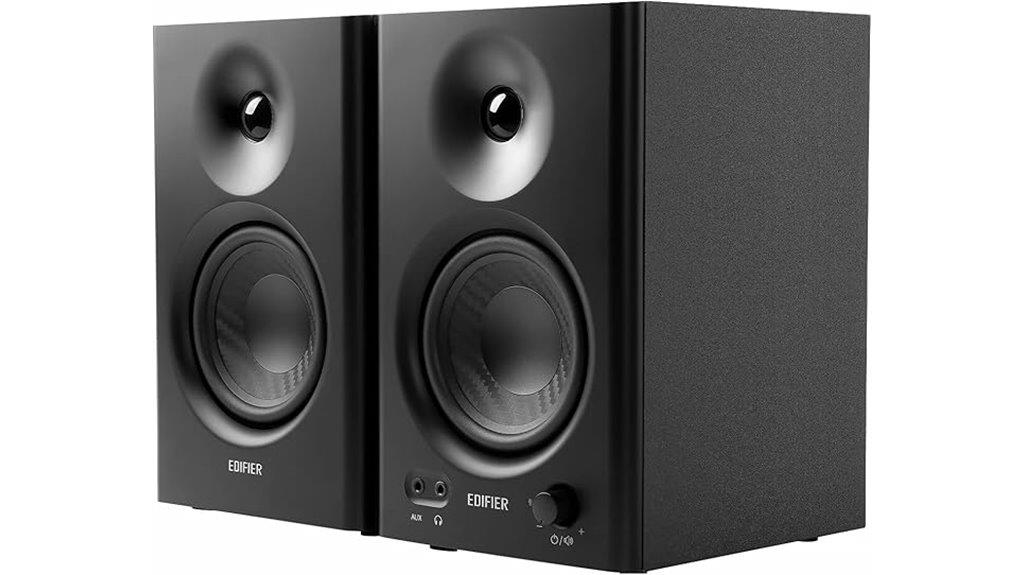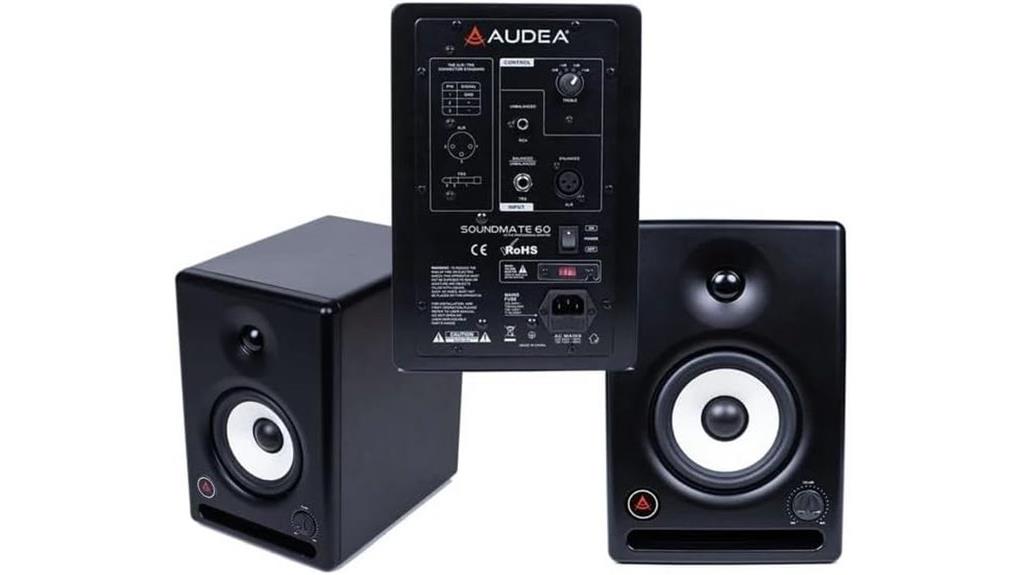If you’re looking to elevate your sound in 2025, I recommend checking out versatile options like the Sound Town clamp-on stands, Edifier MR4 for accurate studio mixing, and Majority Bluetooth speakers for convenience. For professional-grade clarity, the Audea Sound Mate and PreSonus Eris E5 stand out, while KRK 5 Classic offers great reliability for home setups. Keep exploring this guide to find the best fit for your needs and workspace.
Key Takeaways
- Consider monitors with flat frequency response for accurate, honest sound reproduction essential for professional mixing.
- Evaluate connectivity options like XLR, TRS, and digital inputs to ensure seamless integration with your setup.
- Select monitors with appropriate size and wattage for your room dimensions to achieve optimal sound clarity.
- Prioritize build quality and durable materials to maintain consistent performance over time.
- Look for features such as acoustic tuning controls and room calibration to enhance sound accuracy in your environment.
Sound Town 2-Pack Desktop Clamp-On Monitor Stands

If you’re looking to optimize your audio setup, the Sound Town 2-Pack Desktop Clamp-On Monitor Stands are an excellent choice for studio professionals and home audiophiles alike. These stands feature sturdy C-clamps that fit desks up to 2 inches thick, providing secure support for monitors weighing up to 55 pounds each. The 10″ x 9.8″ platforms are lined with soft EVA to protect your gear and allow flexible orientation—horizontal or vertical. With adjustable height from 10.4″ to 13.6″ and tilt from 0-40°, you can customize your listening angle for the perfect sound. They’re versatile, stable, and easy to install.
Best For: studio professionals, home audiophiles, and anyone seeking a stable, adjustable platform for monitors or small speakers on their desk.
Pros:
- Supports speakers weighing up to 55 lbs for heavy-duty stability
- Adjustable height (10.4″ to 13.6″) and tilt (0-40°) for customized sound positioning
- Clamps securely to desks up to 2″ thick, suitable for various workspace setups
Cons:
- May require tools for installation or adjustments
- Limited to desk surfaces up to 2″ thick, not suitable for thicker desks
- The soft EVA lining may wear over time with heavy use
Edifier MR4 Powered Studio Monitor Speakers (Pair)

Looking for compact studio monitors that deliver professional-grade sound without taking up too much space? The Edifier MR4 Powered Studio Monitor Speakers are perfect for that. These 4-inch active near-field speakers offer clear, accurate audio with a silk dome tweeter and four composite woofers. The MDF wood construction minimizes resonance, ensuring true sound reproduction. They feature versatile connectivity—TRS, RCA, AUX, and a headphone jack—making them compatible with various devices. User-friendly controls include separate high and low-frequency adjustments and a mode switch for monitoring or casual listening. Compact yet powerful, they’re ideal for creators who need precise sound in a small footprint.
Best For: music creators, artists, and audio professionals seeking compact, studio-quality sound for accurate audio monitoring and casual listening in small spaces.
Pros:
- Delivers clear, accurate sound with a silk dome tweeter and four composite woofers
- Versatile connectivity options including TRS, RCA, AUX, and headphone jack
- User-friendly controls with separate high and low-frequency adjustments and a mode switch
Cons:
- Limited to 4-inch drivers, which may not produce deep bass for all users
- Compact size might not satisfy those needing larger, more powerful monitors
- Requires placement on stable surfaces to minimize resonance despite MDF construction
Majority Powered Bluetooth Bookshelf Speakers

Majority Powered Bluetooth Bookshelf Speakers like the D40X are ideal for anyone seeking a stylish, compact setup with powerful, room-filling sound. Their bold design features vibrant yellow Kevlar woofers, adding a pop of color to any space. Despite their small size, they deliver 70 watts of robust audio, with clear mid-range, punchy bass, and crisp highs. Connectivity options are versatile, including Bluetooth 5.3, RCA, Optical, AUX, and USB/SD slots. Setup is straightforward, and the included remote makes tuning easy. Overall, the D40X offers impressive sound at an affordable price, making them a popular choice for desktop, bookshelf, or indoor use.
Best For: music enthusiasts, casual listeners, and those seeking stylish, compact bookshelf speakers with powerful sound for indoor use.
Pros:
- Stylish design with vibrant yellow Kevlar woofers adds visual appeal
- Robust 70-watt power output delivers clear, room-filling sound
- Versatile connectivity options including Bluetooth 5.3, RCA, Optical, AUX, and USB/SD
Cons:
- Bass may drop at low volumes, requiring adjustments for optimal sound
- Shorter connection cables can limit placement flexibility
- Not waterproof or water-resistant, suitable only for indoor environments
Audea Sound Mate Studio Monitor Speaker

The Audea Sound Mate Studio Monitor Speaker stands out as an excellent choice for musicians, producers, and audio enthusiasts who demand high-resolution sound in a compact design. It delivers crystal-clear, detailed audio with 2.75-inch aluminum diaphragm drivers, making it perfect for near-field monitoring. Its versatile connectivity includes XLR, RCA, and 1/8-inch inputs, ensuring compatibility with various devices. The sleek, modern look fits well into any studio or home setup, and its lightweight build makes placement easy. Users praise its minimal distortion, rich treble, and balanced sound, making it ideal for mixing, editing, or casual listening.
Best For: musicians, producers, and audio enthusiasts seeking high-resolution, accurate sound in a compact and versatile studio monitor.
Pros:
- Crystal-clear, high-resolution audio with minimal distortion and rich treble
- Versatile connectivity options including XLR, RCA, and 1/8-inch inputs for wide device compatibility
- Compact, stylish design with lightweight build, ideal for desktop and small studio setups
Cons:
- Limited speaker size (6 inches) may not produce deep bass without a subwoofer
- Requires additional equipment for optimal low-end performance (e.g., powered subwoofer)
- Some users may prefer larger monitors for more extensive sound coverage
PreSonus Eris E5 2-Way 5.25 Near Field Studio Monitor

If you’re serious about achieving accurate mixes, the PreSonus Eris E5 2-Way 5.25 Near Field Studio Monitor is an excellent choice, especially for home studio owners and project producers. It delivers clear, detailed sound with a 5.25-inch woven composite woofer for tight lows and a 1-inch silk-dome tweeter for smooth highs. The 80-watt Class AB bi-amplification offers plenty of headroom, while the acoustic tuning controls let you optimize sound for your environment. Plus, it comes with Studio One Prime and the Studio Magic suite, adding valuable tools for music creation. Overall, it’s a versatile, reliable monitor that elevates your mixing accuracy.
Best For: home studio owners and project producers seeking accurate, high-quality monitoring for music production.
Pros:
- Delivers clear, detailed sound with minimal distortion thanks to woven composite woofer and silk-dome tweeter.
- 80-watt Class AB bi-amplification provides ample volume and headroom for various studio environments.
- Comes with valuable software tools like Studio One Prime and Studio Magic suite to enhance music creation.
Cons:
- May require some tuning adjustment for optimal performance in unique acoustic spaces.
- Lacks wireless connectivity options, limiting flexibility in setup.
- Built-in controls and features might be overwhelming for beginners unfamiliar with studio monitors.
KRK 5 Classic Studio Monitor

Looking for an affordable yet high-quality studio monitor that delivers accurate sound across all frequencies? The KRK 5 Classic Studio Monitor fits the bill perfectly. With over 30 years of innovation, it offers a flat frequency response ideal for critical listening, plus an optional +2dB bass boost. Its compact, lightweight design minimizes resonance and distortion, while features like a front-slotted bass port and detailed imaging waveguide enhance placement and clarity. Equipped with a soft dome tweeter and a 5” woofer, it provides smooth highs and tight bass. Reliable, versatile, and suitable for home studios, the KRK 5 Classic is a solid choice for anyone seeking professional sound at an accessible price.
Best For: Home studio enthusiasts, beginner to intermediate music producers, and content creators seeking accurate and affordable monitor speakers.
Pros:
- Flat frequency response for precise critical listening and mixing
- Compact, lightweight, and easy to place in various environments
- Versatile connectivity options and optional bass boost for tailored sound
Cons:
- Bright high frequencies may require adjustment during mastering
- Not designed for room-shaking bass; best suited for nearfield listening
- Slight risk of shipping damage; careful inspection recommended upon arrival
Factors to Consider When Choosing a Professional Studio Monitor Speakers Buying Guide

When selecting professional studio monitor speakers, I focus on sound accuracy and clarity to guarantee my mixes translate well. I also consider room size compatibility and connectivity options to make setup easy and effective. Finally, I look at power, build quality, and durability to find speakers that will perform reliably over time.
Sound Accuracy and Clarity
Achieving sound accuracy and clarity in studio monitors is essential for precise mixing and mastering. Flat frequency response guarantees the sound reproduces the original audio without coloration, giving you an honest representation of your work. High-quality components, like silk dome tweeters and composite woofers, deliver detailed high and mid-range frequencies, enhancing clarity. Precise stereo imaging and a well-defined soundstage allow you to identify spatial differences and position elements accurately. Proper acoustic tuning controls, such as EQ adjustments and room calibration, help maintain consistent sound clarity across various environments. Additionally, minimal distortion at high volumes ensures your audio remains clear and true to the source. These factors are critical for professional-grade sound, helping you produce polished, accurate mixes every time.
Room Size Compatibility
Choosing the right studio monitors involves more than just sound quality; the room size plays a significant role in making sure your speakers perform ideally. Larger rooms require monitors with higher wattage and bigger drivers, like 6-8 inches, to deliver full-range sound without distortion. Smaller spaces benefit from compact monitors with lower wattage and smaller drivers, around 4-5 inches, to avoid overwhelming the environment. It’s also important to think about the frequency response—larger rooms often need flatter responses for accurate mixing. Additionally, proper placement and acoustic treatment tailored to your room size can enhance the monitors’ effectiveness. Matching your monitor’s power and driver size to your space guarantees clear, balanced sound and accurate translation, making your mixing process more precise and enjoyable.
Connectivity Options Available
Selecting studio monitor speakers requires careful consideration of their connectivity options, as these determine how easily you can integrate them into your existing setup. Most monitors offer a range of connections like XLR, TRS, RCA, AUX, and digital inputs such as optical or USB, to suit different devices. Balanced connections like XLR and TRS are preferred for professional environments because they reduce noise and interference, ensuring clearer sound. Unbalanced options like RCA and AUX are common for consumer gear but may be prone to hum or signal loss over longer cables. Some monitors feature multiple input types simultaneously, making switching between sources seamless—whether connecting to a computer, mixer, or audio interface. Digital features like Bluetooth or optical inputs add versatility, especially for modern, wireless setups.
Power and Volume Range
Power and volume range are essential factors in ensuring your studio monitor speakers perform well in your space. The power output, measured in watts, determines how loud your speakers can get and their ability to fill a room without distortion. A wider volume range allows for more precise control over sound levels, which is critical when mixing or listening critically. Higher wattage monitors generally deliver cleaner sound at higher volumes, especially in larger rooms. It’s important to match the peak volume capacity to your room size and intended use to avoid audio clipping or distortion. Additionally, understanding the speaker’s sensitivity rating, expressed in dB, helps you gauge how loud they will get with a given input power, ensuring you choose a monitor that can meet your sound level needs effectively.
Build Quality and Durability
When evaluating studio monitor speakers, build quality and durability play a critical role in guaranteeing consistent performance over time. High-quality monitors usually feature sturdy enclosures made from MDF, wood, or reinforced composites, which minimize resonance and distortion. This robust construction not only supports long-term reliability but also helps maintain accurate sound reproduction during extended use. Well-built monitors often include reinforced drivers and protective grills that prevent damage from impacts, safeguarding your investment. Using premium materials in the cabinet and components enhances sound clarity and reduces unwanted vibrations. Ultimately, reliable build quality ensures your monitors stay calibrated and deliver precise audio, which is essential for critical listening and mixing. Investing in durable, well-designed speakers pays off with consistent, professional-grade sound.
Frequency Response Range
Have you ever wondered how studio monitors can accurately reproduce both deep bass and shimmering high notes? The answer lies in their frequency response range. A wider range guarantees that low frequencies, around 40-50Hz, are clear and powerful, while high frequencies up to 20kHz or more deliver crisp cymbals and sibilance. Professional monitors typically feature a flat frequency response curve, meaning they output sound true to the original recording without coloration. This accuracy is vital for detailed mixing, as it reveals nuances that might otherwise be masked. When choosing monitors, paying attention to their frequency response helps ensure you get a balanced sound tailored to your production needs. It’s about finding a monitor that faithfully reproduces the full spectrum of audio, from deep lows to sparkling highs.
Budget and Price Range
Setting a clear budget before shopping for studio monitor speakers helps you focus on options that fit your financial limits and prevent overspending. Entry-level models start around $100 per pair, but higher-end options can cost several hundred dollars or more. It’s essential to find a balance between price and features, such as connectivity, power output, and build quality, to get the best value for your money. Cheaper monitors might lack advanced acoustic tuning or high-frequency response, which are critical for accurate sound reproduction. Consider your intended use—whether casual listening, mixing, or mastering—and allocate funds accordingly. Investing within your budget ensures you select monitors that meet your needs without stretching beyond your means, ultimately helping you make a smarter, more satisfying purchase.
Frequently Asked Questions
How Do Studio Monitor Speakers Differ From Regular Home Speakers?
Studio monitor speakers differ from regular home speakers mainly in their accuracy and flat response. I find that monitors provide a true representation of sound without boosting bass or treble, helping me make precise mixes. Unlike home speakers, which often enhance certain frequencies for a richer sound, monitors aim for transparency, so I can trust what I hear is exactly what’s recorded, ensuring professional-quality audio production.
What Is the Ideal Size for Studio Monitors in Small Rooms?
In small rooms, I recommend studio monitors around 5 to 6.5 inches. They provide enough bass response without overwhelming the space or causing excessive reflections. Larger monitors can sound great but might be too powerful and muddle the mix in tight spaces. I’ve found these sizes strike a good balance—delivering clarity and accurate sound reproduction so you can mix confidently without worrying about room size limitations.
How Important Is Frequency Response for Professional Studio Monitors?
Frequency response is essential for professional studio monitors because it shows how accurately they reproduce sound across all pitches. I’ve learned that a flat, wide response helps me hear every detail, making mixing and mastering more precise. When monitors accurately represent the full range, I trust my mixes will sound great on any system. So, I always prioritize monitors with a broad, flat frequency response for professional work.
Can I Use Consumer Speakers for Professional Mixing?
You can use consumer speakers for professional mixing, but it’s not ideal. I’ve found that consumer speakers often lack the flat frequency response and accuracy needed for precise mixing decisions. They might sound good for casual listening, but they can mislead you about your mix’s true sound. Investing in studio monitors guarantees you hear an honest, uncolored representation of your tracks, helping you produce professional-quality sound every time.
What Are the Benefits of Powered Versus Passive Studio Monitors?
Powered studio monitors have built-in amplifiers, making setup easier and reducing clutter, which I find really helpful. They often provide a cleaner, more consistent sound because the amp and speaker are designed to work together. Passive monitors need an external amplifier, giving me more flexibility but requiring extra equipment. Overall, powered monitors are more convenient for most setups, but passive ones can be better if I want customization and control over my amplification.
Conclusion
Choosing the right studio monitor speakers is like finding the perfect pair of shoes—they can make or break your sound experience. Whether you’re setting up a home studio or upgrading your gear, I hope this guide helps you find that ideal match. Remember, great sound isn’t just heard; it’s felt. So trust your ears, stay curious, and let your music resonate with clarity and passion. Your perfect sound journey starts here—happy listening!










